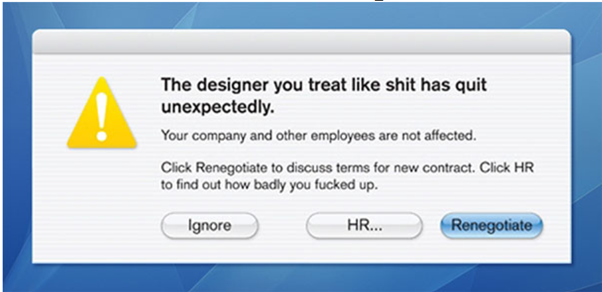I read an article on Bored Panda titled, “89 people who quit their jobs with style.” This resignation message caught my attention. One of the employees quit, and they found this on his desktop.

So, there you have instructions on “how not to treat your employees”. Here is another masterpiece from Dilbert. Though this is so dated, it is still relevant in context and content.

Most people who work in organizations endure a period of office work or any other kind of work that is not so interesting. The most common reasons for attrition are low pay, lack of opportunities to advance, feeling disrespected, and an overbearing boss. The fantasy of telling them all about it and giving your resignation can become overwhelmingly tempting.
I am sure all of you must have heard the term “Great Resignation,” which is what has been happening worldwide. It is also called the ‘Big Quit’ and ‘Great Reshuffle’. The term ‘Great Resignation’ was coined by organizational psychologist and professor of management at Mays Business School at Texas A&M University, Anthony Klotz.
In May 2021, Klotz predicted that the COVID-19 pandemic would cause pent-up resignations. Klotz theorized that the initial surge of workers quitting was caused by the backlog of workers who weren’t leaving during the height of the pandemic. A recent PWC survey states that 71% of those who resigned cited pay as the main factor for wanting to change jobs. 88% of companies experienced a higher turnover than usual. The highest attrition in the last year has been in the IT and healthcare sectors. The reasons attributed are heavy workload coupled with less time fuelling burnout.
How do you handle this?
In the recent past, most employee replacements have resulted in an increased CTC of anywhere between 150 and 200%. This is more problematic if you are a small or a mid-sized enterprise. It would help if you looked for outside help to tide over the challenges of losing critical employees. Organizations like ours provide like-for-like replacements immediately that ensure your business continuity.
How are we able to retain employees with critical skills?
I will share my personal experience of how we retain our employees and how we find replacements for the ones we lose. We have had attrition only in the lower single digits in the last year, and we haven’t had many issues finding replacements. I am going to talk about what worked for us. We have a strong network, and we hire from our network or through solid recommendations from people we trust. This route has been the “go-to” medium for all our critical roles. We attract talent because of our work and the environment we create for doing that work. Some of the attributes of the environment that we create include:
● We offer greater flexibility like reduced hours, shorter work weeks, and the ability to work when and where they want
● We offer wellness packages to our employees
● We invest in professional development through training and workshops and provide access to self-paced learning platforms
● Hybrid work is part of the culture now. We provide the option to work from home and from the office, with no compulsion to do either one of them involuntarily.
● Provide people with a clear career trajectory. In case any of the employees feel stagnated, we talk to them and rejig them to some other function based on their interests coupled with appropriate training
● We use rewards and recognition as a motivator. We reward initiatives and not just results
● Peer relationships and job satisfaction are the hygiene factors on which we thrive
● Provide opportunities for people to network
● Like we assign an executive sponsor to every customer account, we assign a mentor or coach to every employee
All of these have helped us keep the turnover rates low to a large extent. Still, a few leave the organization for various reasons, but overall, this would help any organization stifle the turnover rates.

